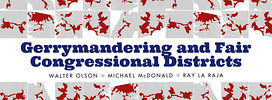Thanks to Michael McDonald and Raymond J. La Raja for their kind words on my essay. I agree almost entirely with Michael McDonald’s points about the value of transparency, in particular open source data sharing methods that allow members of the public to employ free or low-cost software platforms to analyze underlying data and talk back. Public map submission can be especially powerful in providing a basis for judicial review, as his Pennsylvania anecdote (which is among my own favorites) shows. Public data transparency was among the key recommendations of Gov. Larry Hogan’s Maryland Redistricting Reform Commission, which I helped chair, when we issued our report two years ago.
I agree with much of what Raymond La Raja writes as well. Indeed, I may agree with him more than he realizes, since I have not been an advocate for elevating party competitiveness into a redistricting goal in itself by introducing some sort of artificial bias in favor of maps that yield more party-competitive districts. A better course, it seems to me on current evidence, is to pursue other neutral and impartial districting criteria and let the chips fall where they may on competitiveness. Given the geographic lumpiness of voter preference, the result is likely to be a mix of districts competitive between parties, districts competitive within a party via primary, and districts that count as safe for some incumbent or other well-situated person. Nothing wrong with those outcomes, so long as they have not resulted from the placing of a thumb on the scales.
Parenthetically, we can all agree that the federal Voting Rights Act introduces complexities by sometimes validating or requiring departures from otherwise neutral redistricting practice. This necessarily builds an additional stage into decisionmaking, since qualified experts or lawyers versed in VRA rules must be afforded a look at maps under consideration so as to flag any that (even by inadvertence) are VRA-noncompliant. But the VRA as I understand it is a law aimed at protecting minority voters, not particular incumbents or parties, so it’s hard for me to see why it should stand in the way of a project of blinding decisionmakers to the latter sorts of data.
I can’t agree with, but as an intellectual matter will admit to being fascinated by, the contrarian case for deliberately allowing some measure of rent-seeking, incumbent perks, and insulation so as to grease the gears for cooperation within lawmaking bodies. It reminds me of the argument that it was a mistake to have curtailed congressional earmarks - they helped with logrolling, which led in turn to more consensus and better civility, or so the argument goes. And I know from overhearing elected officials chatting among themselves that some of them do yearn to loosen the tight grip that they believe the electoral process currently holds on them. We have to campaign constantly! We have to fundraise constantly! How can they expect us to act like Burke or Disraeli, Daniel Webster or Henry Clay? At least without a nice safe seat. That’s the ticket - more safe seats all round!
But if one conceives of the relationship between voters and representatives as one between principals and agents, I am not convinced that the answer is to give the agents more independence from the fear of being fired by their principals. Note also that one of the neutral redistricting criteria followed in many jurisdictions - minimize the shifts in district lines between one census and the next, so that not too many more voters are thrown into new districts than population shifts would require - already works to the benefit of political continuity and, I suspect in more cases than not, incumbent interest.
Let me return to a note of agreement, though. All the available models of reform - the New Jersey “harness politics to tame politics” model, the Iowa civil service model, the citizen commissions, and so forth - have pluses and minuses. It’s way too early to call an end to experimentation and declare one the winner, especially when different methods may fit better into the political cultures and histories of different states. Prof. Bruce Cain has made a good case that the New Jersey model shows promise, even if it some of us worry that its structure might encourage bipartisan incumbent protection. Let a dozen other state-level experiments proceed.

